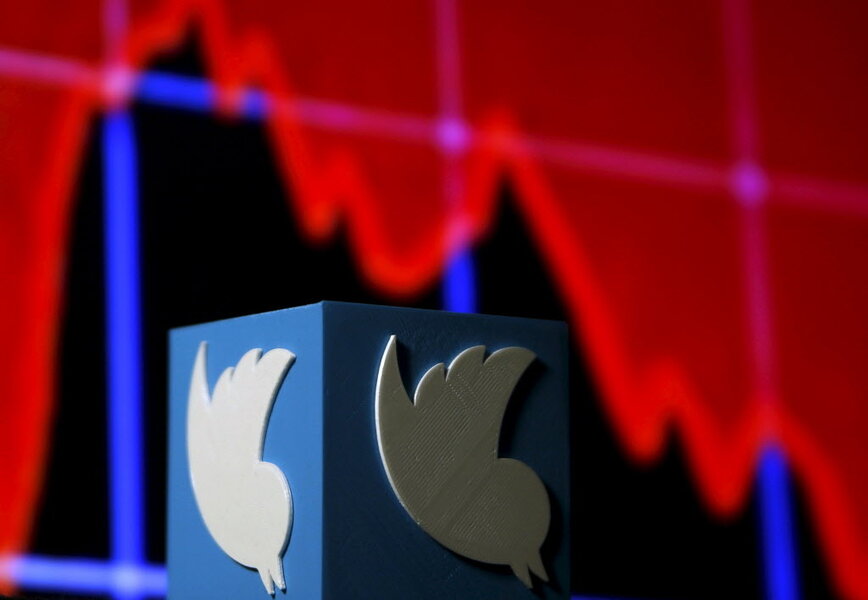To keep the network growing, Twitter revamps people's timelines
Loading...
After a week of rumors, Twitter said it is introducing an algorithm-based timeline that will show tweets out of order, a move that marks a break with the reverse-chronological format that has been the service’s trademark.
Beginning on Wednesday, Twitter will initially show users tweets that it predicts they will most want to see at the top of its timeline, beginning with the most recent first.
But unlike Facebook’s News Feed, which is wholly based on relevance, new tweets only appear after someone opens the website or app and starts scrolling. Below those selected tweets, users see their timelines in reverse chronological order.
“We've already seen that people who use this new feature tend to Retweet and Tweet more, creating more live commentary and conversations, which is great for everyone,” wrote Mike Jahr, a senior engineering manger at Twitter, in a blog post announcing the change.
Amid a series of financial struggles and internal turmoil, the company has particularly sought to woo advertisers, who have complained that their tweets can get lost in the reverse-chronological timeline.
As some tech writers and critics have predicted, the new timeline is more of an expansion of Twitter’s “while you were away” feature — introduced a year ago — than a full-scale overhaul of the service.
The company says users will be able to opt-in to the feature using the “show me the best Tweets first” setting in the service’s “Timeline” settings using its website or mobile apps. In the coming weeks, users will receive a notification that the feature has been switched on.
But algorithm-based services have also faced criticism from researchers and some users over whether they filter users’ experiences to reinforce their own views and show them perspectives much like their own, a debate that has particularly swirled around coverage of the protests in Ferguson, Mo., which were widely chronicled on Twitter.
“Twitter brims with human judgment, and the problem with algorithmic filtering is not losing the chronology, which I admit can be clumsy at times, but it’s losing the human judgment that makes the network rewarding and sometimes unpredictable,” wrote Zeynep Tufekci, a sociologist who teaches at the University of North Carolina's School of Information and Library Science, in a Medium post in 2014.
She has noted that the Ferguson protests were – at least in her own news feed – initially obscured by Facebook’s algorithm in favor of the popular “Ice Bucket Challenge” videos and other content.
A study that year by researchers at the University of Texas at Austin found that members of Congress were also twice as likely to use Twitter as Facebook, citing the service’s rapid-fire potential to get their messages out, as well as interact with constituents.
The move comes at a delicate time for the site. While many users expressed dismay at the rumored changes last week using the hashtag #RIPTwitter, prompting a cautiously-worded assurance from chief executive Jack Dorsey that the site would remain “live” and become "more Twitter-y,” the company has also been fielding concerns from investors and advertisers about its financial future.
Last quarter, Twitter reported that it had 320 million users, a number that remained essentially unchanged from the previous quarter. Its revenue projections also fell below Wall Street analysts’ estimates, despite coming during the typically busy holiday season. Twitter is set to release its most recent financial results on Wednesday afternoon.
The company is hoping to woo advertisers as well, particularly betting on the idea that the new timeline could help ensure that new users who may feel overwhelmed by an initial stream of tweets would return to the site.
In a blog post directed at brands, the company said it found that tests of the new timeline showed that more users were likely to engage with ads and tweets about live events using the new format.
Using a smaller number of initial tweets could also encourage people who check the service less frequently to return more often.
While Mr. Dorsey, who returned as chief executive last fall, has won praise for addressing some issues head-on – such as improving the company’s diversity, a long-running struggle in Silicon Valley – the question of what impact the new timeline may have on the site has been hotly debated.
“The problem with filtering is that the algorithm—which of course is programmed and tweaked by human beings, with all their unconscious biases and hidden agendas—is the one that decides what content you see and when,” wrote Fortune’s Matthew Ingram.
In the case of Facebook, a study led by researchers at the University of Illinois of a small group of users found that more than 60 percent did not know that the site was filtering their feeds at all. After learning of the features, the researchers noted, most of the survey’s participants said they were still satisfied with the site’s features after learning of the filtering. Some also said they began using the features more after learning of them.
But one former Facebook executive argued those concerns weren’t as relevant in the days leading up to Twitter’s announcement.
“Algorithmic feed was always the thing people said they didn't want but demonstrated they did via every conceivable metric. It's just better,” Bret Taylor, Facebook’s former chief technology officer, wrote last week on Twitter.
This perspective can be controversial, with the Massachusetts Institute of Technology professor Shelly Turkle, who studies how technology impacts how people communicate, writing that “the Net teaches us to need it.”
In the wake of the Ferguson protests, which also helped catapult the Black Lives Matter movement into the national spotlight, Professor Tufekci noted that this seemingly abstract debate can often spill into the real world.
“How the Internet is run, governed and filtered is a human rights issue,” she wrote in 2014. “And despite a lot of dismal developments, this fight is far from over, and its enemy is cynicism and dismissal of this reality.... Algorithms have consequences.”







